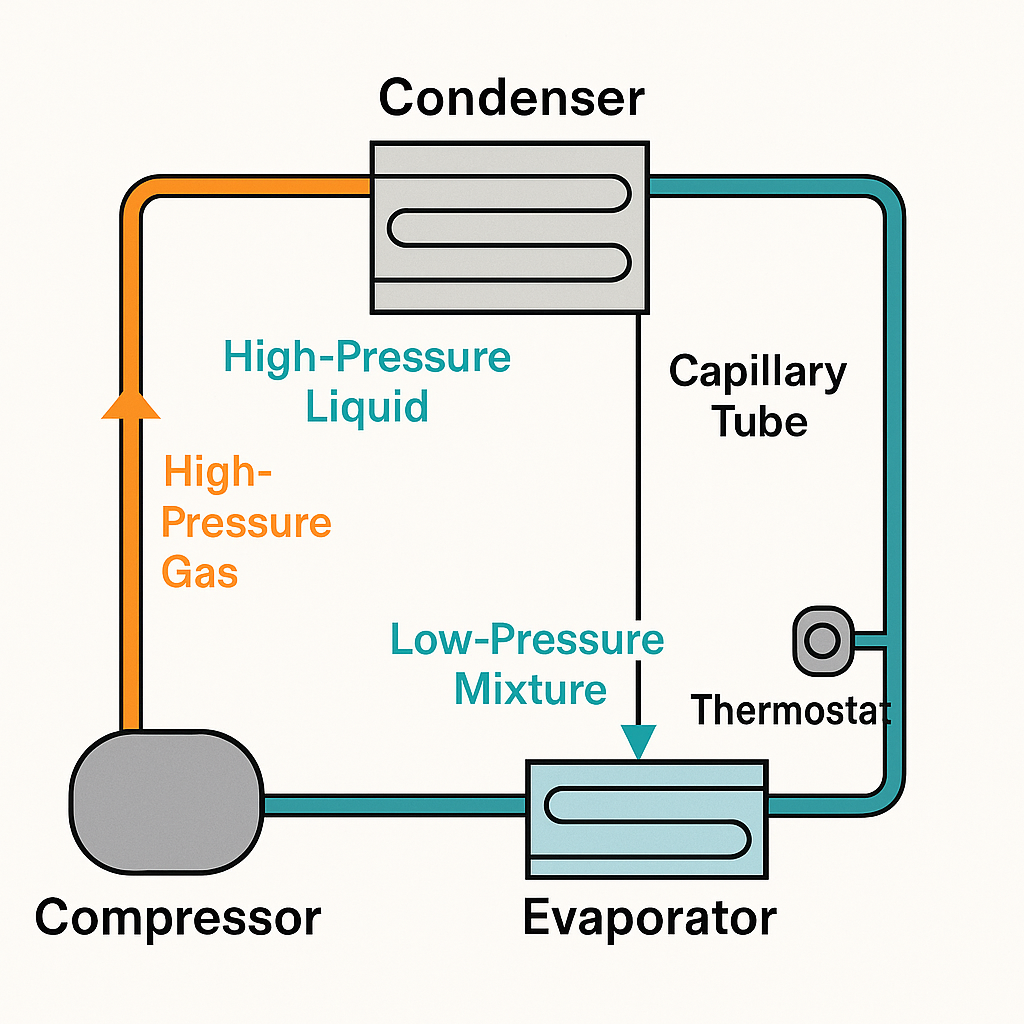In a domestic refrigerator, a capillary tube controls the flow of refrigerant from the
A. Expansion valve to the evaporator
B. Evaporator to the thermostat
C. Condenser to the expansion valve
D. Condenser to the evaporator
Answer: Option D
Solution (By Examveda Team)
Correct Answer: Option D — Condenser to the evaporatorKey Idea: In domestic refrigerators, the capillary tube itself is the expansion device. It directly connects the condenser outlet (high-pressure liquid) to the evaporator inlet (low-pressure region) and creates the required pressure drop to enable refrigeration.
Cycle Overview (Flow Path): Compressor → Condenser → Capillary Tube → Evaporator → back to Compressor
What Happens Physically:
After compression, the refrigerant is a hot, high-pressure gas.
In the condenser, it rejects heat to surroundings and becomes a high-pressure liquid.
This liquid enters the capillary tube (a long, narrow tube). Due to its small internal diameter and length, it imposes a flow resistance, causing a substantial pressure drop from condenser pressure to evaporator pressure.
Because of the pressure drop, a portion of the liquid flashes (evaporates) and its temperature falls close to the saturation temperature corresponding to the low evaporator pressure.
The low-pressure mixture then enters the evaporator, where it absorbs heat from the refrigerator compartment and fully evaporates, producing the desired cooling.
Why Capillary Tube Is Used in Domestic Refrigerators:
• It is simple, inexpensive, and reliable (no moving parts).
• It provides automatic flow regulation to some extent: when load decreases, evaporator pressure drops, mass flow reduces through the restriction, helping maintain stable operation.
• It suits the small, steady loads typical of household refrigerators and works well with on–off (cycling) control of the compressor by a thermostat.
Why the Other Options Are Incorrect:
• Option A (Expansion valve to the evaporator): An expansion valve is a different device. Most domestic units do not use a thermostatic expansion valve; they use a capillary tube. Hence, this connection description does not apply to capillary-tube systems.
• Option B (Evaporator to the thermostat): The thermostat is a control/sensing device, not part of the refrigerant piping. Refrigerant does not flow to the thermostat; it merely senses temperature and switches the compressor.
• Option C (Condenser to the expansion valve): Again assumes the presence of a separate expansion valve. In a domestic refrigerator, the capillary tube itself performs the expansion, so the correct connection is directly to the evaporator.
Conclusion: The capillary tube controls the flow of refrigerant from the condenser to the evaporator by creating the necessary pressure drop, making Option D the correct choice.


Capillary tube is refrigerant controller they are not used with any other ref control in domestic ref cycle compressor condenser ref control ( Capillary tube) evaporator the best option in my knowledge is D plz explained for my knowledge
Thank you sir
Capillary is used between condenser and evaporetor
condenser to the evaporato
Option D is correct
There is no expansion valve use in domestic refrigerator... They use capillary instead of exp valve....
Option D is the correct answer